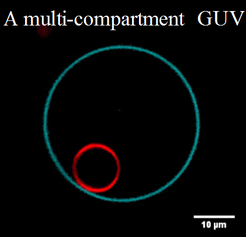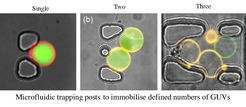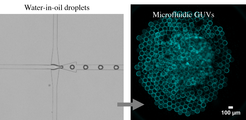Forschung
Multi-compartment lipid membrane systems
Eukaryotic cells have evolved membrane-bound sub-cellular organelles. The advantage of which is to provide spatial organisation of biomolecules, therefore allowing more diverse cellular functionalities. Here, we use GUVs as tools to not only mimic the outer cell membrane, but we also encapsulate smaller GUVs to mimic membrane-bound organelles. These multi-compartment vesicles also called ‘vesosomes’ can be tailored to contain specific biomolecules within each compartment or to contain functional lipids for various applications. By creating these artificial eukaryotic cell-like systems, we hope to gain valuable insights into how biological cells function.

Microfluidics for precise handling of GUVs
While GUVs are powerful tools for creating minimal cells, handling and subsequent imaging is not straightforward. Therefore, we make use of microfluidic platforms which are designed to capture these vesicles in specific spatial locations for on-chip analysis. Depending on the application, we can immobilise defined numbers of GUVs (from single vesicles to 100s) and due to the microfluidic flow control, still be able to add or remove molecules surrounding them. This is particularly advantageous for drug delivery or biophysical applications, but is also essential for triggering events externally in the content of mimicking cell processes.

Microfluidic systems to create giant unilamellar vesicles
Not only do we use microfluidic systems to handling lipid vesicles, but we also use the technology to create GUVs via water-in-oil droplets. Double emulsion templates are created by microfluidic droplets at high-throughput rates (kHz), and the organic phase is later removed leaving highly mono-disperse microfluidic GUVs (or mGUVs). Compared to bulk methods, the encapsulation efficiencies are high and the sizes of the mGUVs can be precisely tuned from 10 to 150 microns.

Single-cell analysis with microfluidics
Tracking and analysing biological cells on a single-cell level is non-trivial. Microfluidic platforms however, have the unique ability to isolate single cells for individual analyses. We use a variety of approaches including water-in-oil droplets, micro-fabricated posts, and micro-chambers to capture single cells for analysis and tracking over time.




